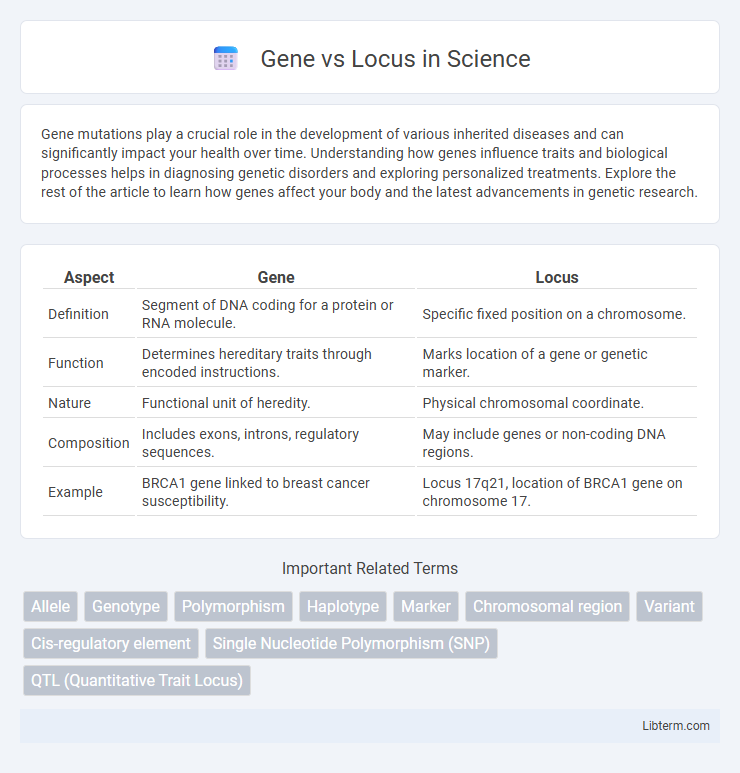Gene mutations play a crucial role in the development of various inherited diseases and can significantly impact your health over time. Understanding how genes influence traits and biological processes helps in diagnosing genetic disorders and exploring personalized treatments. Explore the rest of the article to learn how genes affect your body and the latest advancements in genetic research.
Table of Comparison
| Aspect | Gene | Locus |
|---|---|---|
| Definition | Segment of DNA coding for a protein or RNA molecule. | Specific fixed position on a chromosome. |
| Function | Determines hereditary traits through encoded instructions. | Marks location of a gene or genetic marker. |
| Nature | Functional unit of heredity. | Physical chromosomal coordinate. |
| Composition | Includes exons, introns, regulatory sequences. | May include genes or non-coding DNA regions. |
| Example | BRCA1 gene linked to breast cancer susceptibility. | Locus 17q21, location of BRCA1 gene on chromosome 17. |
Introduction to Genes and Loci
Genes are specific sequences of DNA that encode functional products, typically proteins, which determine inherited traits in organisms. A locus refers to the fixed position or location of a gene or other significant sequence on a chromosome. Understanding the distinction between genes and loci is fundamental in genetics, as loci serve as addresses for genes within the genome.
Defining a Gene
A gene is a defined sequence of nucleotides in DNA that encodes the information necessary to produce a functional product, typically a protein or RNA molecule. It consists of coding regions called exons and non-coding regions called introns, along with regulatory elements controlling expression. A locus refers to the specific physical location of a gene or genetic marker on a chromosome, highlighting its position rather than its function or structure.
What is a Locus?
A locus refers to a specific, fixed position on a chromosome where a particular gene or genetic marker is located. Unlike a gene, which is a functional unit of heredity encoding proteins or RNA, a locus denotes the precise physical location without implying function. Identifying loci is crucial for genetic mapping, studying inherited traits, and understanding chromosomal architecture.
Key Differences Between Gene and Locus
A gene is a specific sequence of DNA that codes for proteins or functional RNA, while a locus refers to the fixed position or location of a gene or DNA marker on a chromosome. Genes contain the hereditary information that determines traits, whereas loci serve as reference points on chromosomes for mapping and identifying genetic variations. The key difference lies in genes being functional units of heredity, whereas loci are physical positions without necessarily implying function.
Gene Structure and Function
A gene is a specific sequence of DNA that encodes functional products, typically proteins or RNA molecules, whereas a locus refers to the precise physical location of a gene or genetic marker on a chromosome. Gene structure includes regulatory regions such as promoters, coding regions comprising exons and introns, and untranslated regions (UTRs) critical for gene expression and transcript stability. The function of a gene is determined by its ability to be transcribed and translated into functional molecules essential for cellular processes, while the locus serves as the chromosomal address that aids in genetic mapping and inheritance studies.
Locus in Chromosomal Mapping
A locus refers to a specific position or region on a chromosome where a gene or genetic marker is located, serving as a reference point in chromosomal mapping. Unlike a gene, which is a functional unit of heredity encoding proteins or RNA, the locus denotes the physical location identifiable through techniques such as fluorescence in situ hybridization (FISH) or genetic linkage analysis. Chromosomal mapping relies on loci to establish the relative positions of genes, enabling the study of genetic traits, inheritance patterns, and the identification of disease-associated regions.
Relationship Between Genes and Loci
Genes are specific sequences of DNA located at particular positions, or loci, on chromosomes, establishing a direct correlation between gene function and chromosomal position. Each locus represents a fixed physical location that can harbor one or more genes influencing phenotypic traits or genetic variation. Understanding the relationship between genes and loci is crucial for mapping genetic disorders, studying inheritance patterns, and conducting genome-wide association studies (GWAS) to identify gene-disease correlations.
Examples Illustrating Gene vs Locus
The BRCA1 gene, located at the 17q21 locus on chromosome 17, exemplifies the distinction where the gene encodes a protein involved in DNA repair, while the locus represents the specific physical address on the chromosome. Another example is the HBB gene, responsible for producing beta-globin, situated at the 11p15.4 locus; this locus indicates its precise chromosomal position independent of the gene's function. The distinction is critical in genetics, as mutations in the gene affect biological function, whereas variations at the locus define genomic mapping and inherited traits.
Importance in Genetic Research
The distinction between gene and locus is crucial in genetic research because a gene represents a specific sequence of DNA that encodes functional products, while a locus refers to the precise physical location of a gene or other significant DNA segment on a chromosome. Understanding loci enables researchers to map genetic traits and identify variations associated with diseases, facilitating gene-linked diagnostics and targeted therapies. Precise identification of genes at specific loci accelerates advancements in genomics, gene editing, and personalized medicine.
Conclusion: Gene and Locus in Modern Genetics
A gene represents a specific sequence of DNA that encodes functional products such as proteins, while a locus refers to the fixed position on a chromosome where a gene or genetic marker is located. In modern genetics, understanding the distinction between gene and locus is crucial for mapping genomes, studying inheritance patterns, and identifying disease-associated variants. Precise gene localization at defined loci enables accurate genetic analysis and facilitates targeted medical research and therapies.
Gene Infographic

 libterm.com
libterm.com